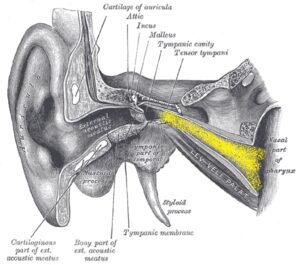Just what is a “Patulous” Eustachian Tube?
Every week I see two or three patients with ear complaints that have been undiagnosed, or misdiagnosed. Many times I will see young adults with a sudden sense of a “popped ear“, “ear pressure“, or “hearing in a barrel“. There will often be a feeling of hearing loss, or a strange sense that one’s own voice is too loud. Oddly this feeling can come and go quickly – sort of snap on and snap off.
Most of the time the ear will look completely normal to the doctor. Hearing tests will often be completely normal as well. Part of a hearing test called “tympanometry” may show some minor abnormalities, but even then the pressure changes of patulous eustachian tube dysfunction can show a normal pressure test.

These cases can be frustrating for doctors! And I know the patient is frustrated too!
In a normal situation, the ear has is a closed off air space (aka “the middle ear“), with a tiny connection to the back of the sinuses called the eustachian tube. The eustachian tube is about 1 1/2 inches in adult and has a soft membrane that is normally flopped closed. When we swallow, yawm, or make certain other throat maneuvers the eustachian tube snaps open for brief second. This happens about every minute and allows the ear pressure to re-equalize.
Some conditions like allergies, sinus infections, or viruses can cause extra swelling of the eustachian tube which prevents it from clearing the ear spaces easily and can lead to ear infections, fluid, or sometimes painful airplane flights when you are sick.

However a “patulous tube” is just the opposite—sometimes the eustachian tube can get stuck in the open position instead of the closed position. Pretty weird! It means that you are suddenly hearing your own voice much differently, and outside sounds are vibrating much differently inside the ear. I’ve had this before for an hour or two and it feels WEIRD. I could not imagine this going on for days or weeks!
Recent weight loss, treatment of allergies, a history eustachian tube swelling/blockage/ear infections can all lead eventually to patulous eustachian tubes. Sometimes we don’t have a good explanation as to why, but it is usually pretty easy to diagnose with an exam and with your doctor asking the right questions. I have seen a lot of patients on semaglutitde and other new generation weight loss meds having new problems with patulous tube.
There has been a renewed interest in eustachian tube problems with the development of eustachian tube balloon dilation, which is a procedure done in the office to address many eustachian tube issues. But there are other procedures that address patulous tubes, sometimes treatments on the ear drum and sometimes therapies targeting the eustachian tubes themselves.

